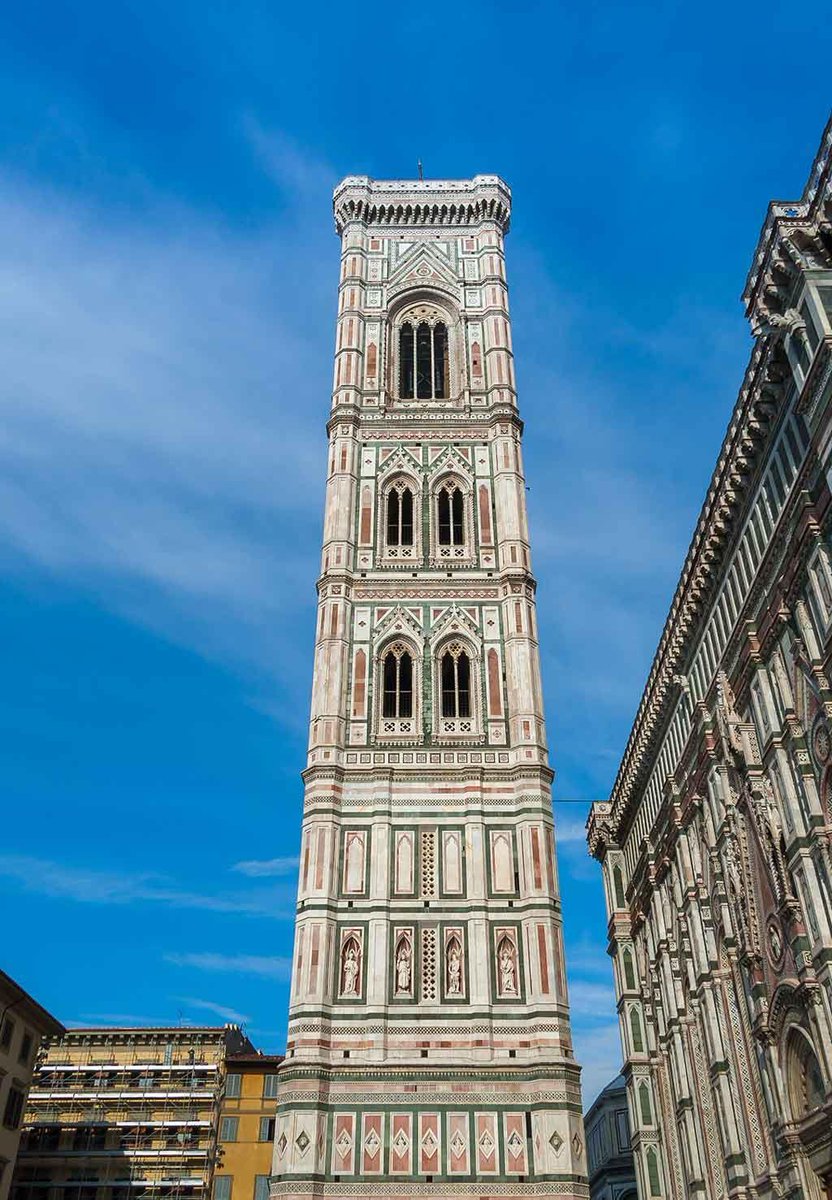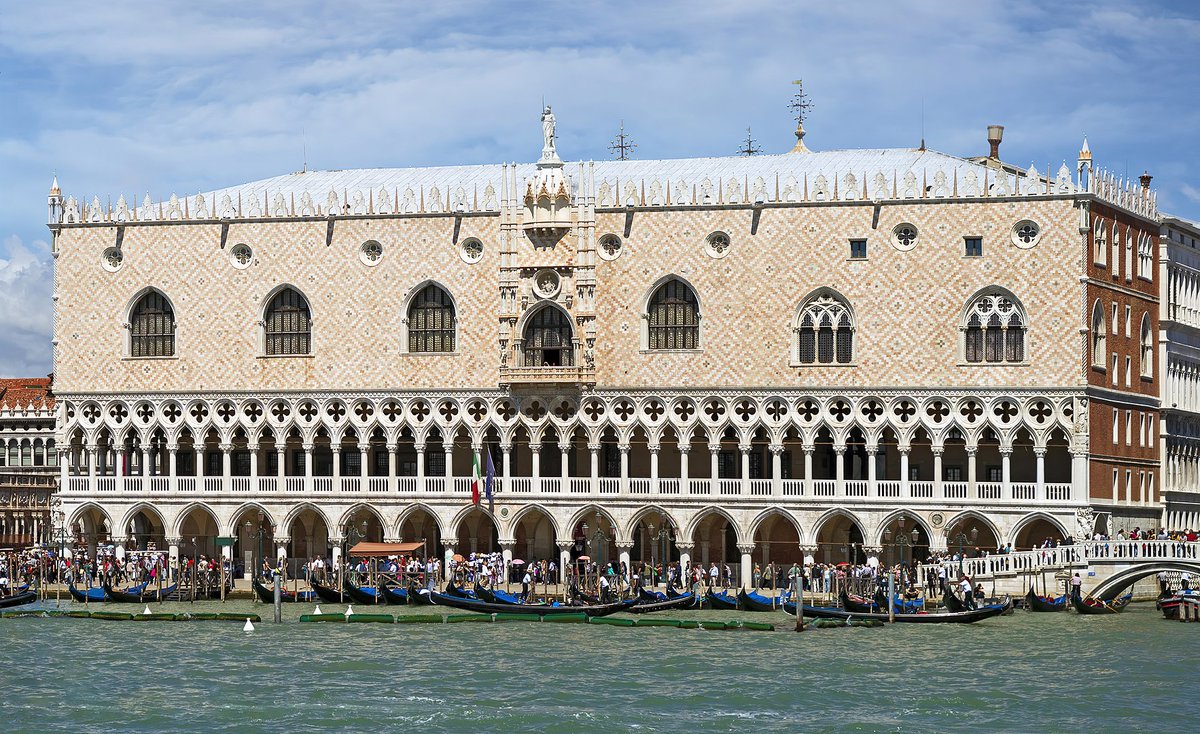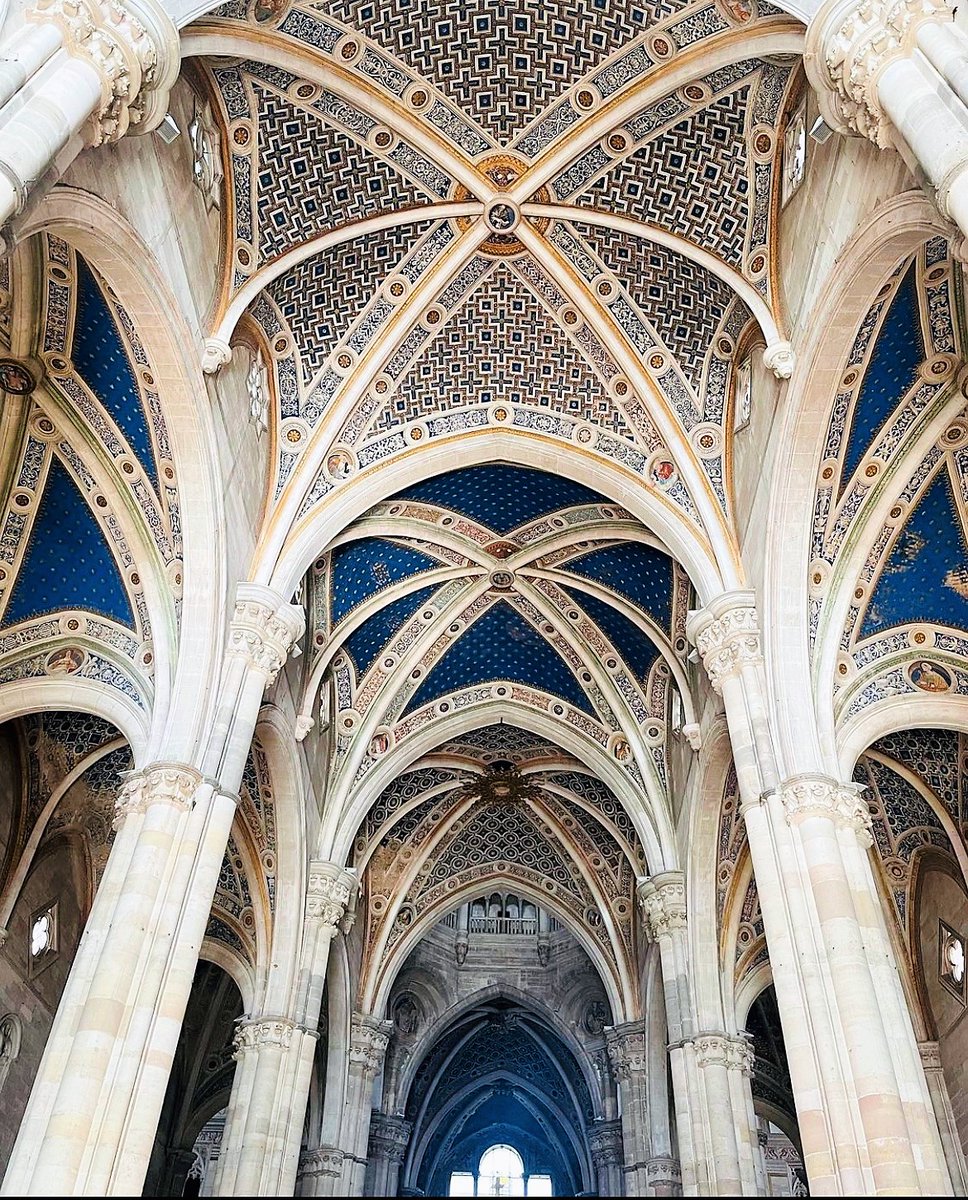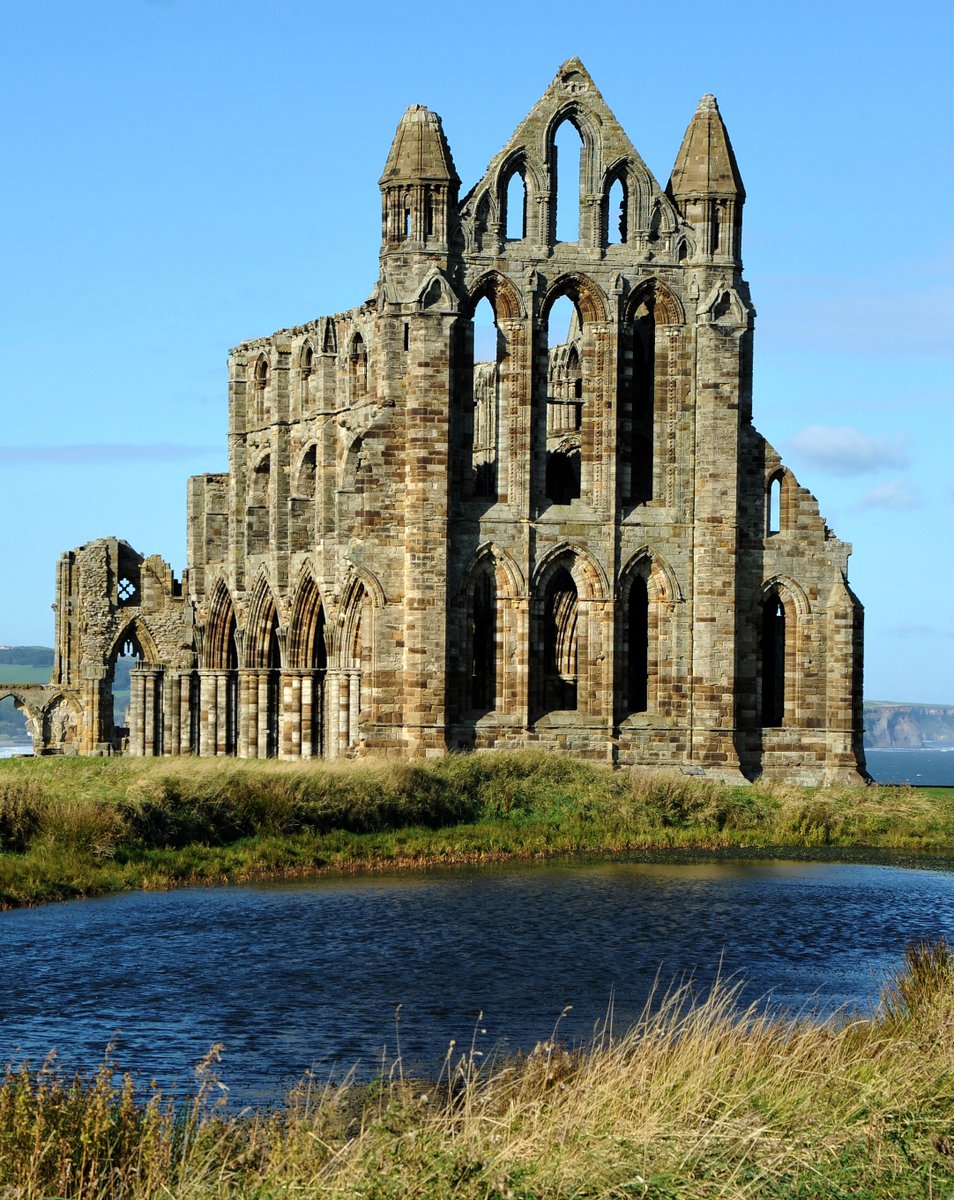This is Orvieto Cathedral, built 600 years ago.
It's the perfect example of an architectural style totally unique to Italy.
So here's a brief introduction to Italian Gothic Architecture — and what makes it different...
It's the perfect example of an architectural style totally unique to Italy.
So here's a brief introduction to Italian Gothic Architecture — and what makes it different...

When you think of "Gothic Architecture" you probably picture something like Rouen Cathedral.
Flying buttresses, large windows, soaring towers, gargoyles, and flowing stonework.
But Gothic Architecture, which emerged in the 12th century, developed differently in Italy.
Flying buttresses, large windows, soaring towers, gargoyles, and flowing stonework.
But Gothic Architecture, which emerged in the 12th century, developed differently in Italy.

The first thing you'll notice about Italian Gothic Architecture is its material.
Whereas churches elsewhere in Europe were usually built with stone, Italian architects used brick.
Consider the (unfinished) Basilica of Saint Anastasia in Verona:
Whereas churches elsewhere in Europe were usually built with stone, Italian architects used brick.
Consider the (unfinished) Basilica of Saint Anastasia in Verona:

The basic model for Italian Gothic churches was to build a structural core of brick and then decorate it with marble.
Hence churches like the Santa Maria Novella in Florence, with an exterior of plain brick apart from its marble-encrusted façade.
Hence churches like the Santa Maria Novella in Florence, with an exterior of plain brick apart from its marble-encrusted façade.

Even the famous Florence Duomo, though now covered in polychromatic marble panels so typical of the Italian Gothic, was designed this way.
Consider its façade, which was left unfinished in the Middle Ages and only completed in the 19th century, during the Gothic Revival.
Consider its façade, which was left unfinished in the Middle Ages and only completed in the 19th century, during the Gothic Revival.

This practice was already common in the days of Romanesque Architecture.
And so whereas in Northern Gothic a single material — such as limestone — was simultaneously structural and decorative, in Italy this wasn't the case.
The Basilica of Santi Giovanni e Paolo in Venice:
And so whereas in Northern Gothic a single material — such as limestone — was simultaneously structural and decorative, in Italy this wasn't the case.
The Basilica of Santi Giovanni e Paolo in Venice:

So, in comparison with their northern counterparts, Italian architects seemed much more content to leave church exteriors undecorated or unfinished.
Still, perhaps the best example of the Italian Gothic love for encrusted façades and an otherwise simple exterior is at Orvieto:
Still, perhaps the best example of the Italian Gothic love for encrusted façades and an otherwise simple exterior is at Orvieto:

And though Northern European architects wanted to build churches as tall as possible, in Italy there was less focus on size.
Notice how Italian Gothic Churches — like San Petronio in Bologna — were built with the same, simple plan as older Romanesque churches.
Notice how Italian Gothic Churches — like San Petronio in Bologna — were built with the same, simple plan as older Romanesque churches.

And the way the Italians decorated the exterior of their churches was carried through to the interiors.
Generally speaking they would whitewash and paint the walls, and otherwise make extensive use of decorative bands of stone in alternating colours.
As at Siena Cathedral:
Generally speaking they would whitewash and paint the walls, and otherwise make extensive use of decorative bands of stone in alternating colours.
As at Siena Cathedral:

The floors of Italian Gothic churches are particularly noteworthy — works of art in their own right.
This was influenced by the Byzantine Empire, who reintroduced to Italy the ancient Roman fashion for floors with patterns of complex, interlocking marble.
This was influenced by the Byzantine Empire, who reintroduced to Italy the ancient Roman fashion for floors with patterns of complex, interlocking marble.

Another major characteristic of Italian Gothic is that churches tended to have small, simple windows.
In Northern Europe the goal was to make windows as large as possible, so they could be filled with stained glass and decorative tracery.
Like the Sainte-Chapelle in Paris:
In Northern Europe the goal was to make windows as large as possible, so they could be filled with stained glass and decorative tracery.
Like the Sainte-Chapelle in Paris:

Not so in Italy, where the main form of decoration was murals rather than stained glass.
Just look at the exterior of the San Fermo Maggiore in Verona — none of those huge windows associated with the Gothic.
Hence the interiors of Northern and Italian churches feel different.
Just look at the exterior of the San Fermo Maggiore in Verona — none of those huge windows associated with the Gothic.
Hence the interiors of Northern and Italian churches feel different.

There were two or three pinnacles of Italian Gothic, each with their own idiosyncracises.
One was in Florence, in the 14th century, epitomised by the Duomo — the dome was an early Renaissance addition.
One was in Florence, in the 14th century, epitomised by the Duomo — the dome was an early Renaissance addition.

Florence's bell tower stands separate to the church, and is therefore called a "campanile".
Campaniles were far more common in Italy than the rest of Europe.
This one was designed by the great Giotto, and captures all that was most delightful about Florentine Gothic:
Campaniles were far more common in Italy than the rest of Europe.
This one was designed by the great Giotto, and captures all that was most delightful about Florentine Gothic:

Meanwhile in Venice a different sort of Gothic Architecture had emerged, and its crowning achievement was the Doge's Palace.
Civic Gothic at its finest.
Civic Gothic at its finest.

Every one of its capitals (the decorative parts at the top of the columns) is different.
This is a vital element of Gothic more broadly — that individual masons had freedom, that there were no unbreakable rules of form or decoration, that all was in constant variation.
This is a vital element of Gothic more broadly — that individual masons had freedom, that there were no unbreakable rules of form or decoration, that all was in constant variation.

Nowhere in Italy was domestic Gothic architecture perfected more than in Venice — although most of it has since been remodelled or destroyed.
The best surviving example is the Ca' d'Oro, meaning "House of Gold", with its arcades based on those of the Doge's Palace.
The best surviving example is the Ca' d'Oro, meaning "House of Gold", with its arcades based on those of the Doge's Palace.

Another high-point was the Pisan Gothic.
This type is encapsulated by the small Santa Maria della Spina, originally built in the 13th century.
It was moved and "restored" in the 19th century, however, losing much of its original character.
This type is encapsulated by the small Santa Maria della Spina, originally built in the 13th century.
It was moved and "restored" in the 19th century, however, losing much of its original character.

In the later days of Gothic Architecture Italy was influenced by some of the more extravagant trends coming from the North.
Consider the façade of St Mark's Basilica in Venice.
The lower part is Byzantine, but the elaborate roofline is Late Gothic at its most ornate.
Consider the façade of St Mark's Basilica in Venice.
The lower part is Byzantine, but the elaborate roofline is Late Gothic at its most ornate.

And, of course, the great exception to Italian Gothic was the Milan Duomo, started in 1386 and not finished for 500 years.
It was modelled on Northern European Gothic — notice the flying buttresses and abundant pinnacles, for example.
Wonderful, but not typical Italian Gothic.
It was modelled on Northern European Gothic — notice the flying buttresses and abundant pinnacles, for example.
Wonderful, but not typical Italian Gothic.

But the age of the Italian Gothic came to an abrupt end.
In the 15th century Renaissance Architecture emerged, inspired by the architecture of Rome.
A classical style consciously opposed to the Gothic in spirit and form, summarised by St Peter's Basilica in Rome.
In the 15th century Renaissance Architecture emerged, inspired by the architecture of Rome.
A classical style consciously opposed to the Gothic in spirit and form, summarised by St Peter's Basilica in Rome.

So that's a brief introduction to the Italian Gothic, and one that explains why Medieval Italian churches look and feel so different.
Less eye-catching and overtly impressive than the colossal cathedrals of Northern Europe, but fabulously subtle and beautiful in its own way.
Less eye-catching and overtly impressive than the colossal cathedrals of Northern Europe, but fabulously subtle and beautiful in its own way.

• • •
Missing some Tweet in this thread? You can try to
force a refresh






















